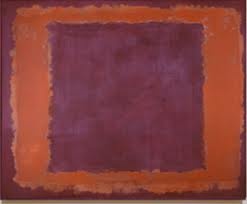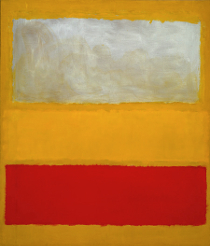An Interruption of the Wallpaper
The Emptiness of Rothko
Saturday, February 2, 2008 4:42 am
I am an optimist. I believe that foolish forms of art endure only so long as they are a means to self-elevation. Once it is no longer the Mark of the Smart Set to gush about a certain sort of art, that art will be abandoned.
Modern art is foolish art. Yet it has been tenacious; here we are, in 2008, and people still revere someone like Mark Rothko. But then, modern art is also the cry of the decadent, and decadence takes a while to play out. Perhaps only at the final passing of our civilization will the noisome banalities be properly held in contempt.
Till then, some of us can keep our senses and call modern art what it is: Art with a capital F.

This is one of Rothko's paintings, untitled, from 1958, part of a larger, unfinished series of murals, intended for the Four Seasons restaurant in the Seagram's Building in New York City. It's like most of his "masterpieces": rectangles of color, arranged just so. Rothko's intentions — when considered with his actual work — are comical. He would speak about myth and intensity. "I'm interested only in expressing basic human emotions, tragedy, ecstasy, doom and so on." His paintings were, he said, the "opposite of restful." What with the recent Holocaust and the existence of the atom bomb, normal depiction of figures and landscapes was out of the question. We had to choose instead a "pure expression of feeling." And thus... behold!

I don't know how to mock this painting of rectangles. It mocks itself. When Rothko says, "The people who weep before my pictures are having the same religious experience I had when I painted them," I can only snort into my beer. If such as the above embodies a "religious experience," we can only imagine what sorts of explosive transcendence Rothko might have achieved had he used triangles or circles.
With his Seagram's murals, in particular, he wanted to inspire a sense of unending confinement, like being trapped in a passage. He wanted to "make those rich sons-of-bitches lose their appetites." Seagram's was paying him millions for the paintings, truly granting him a great compliment; and like all modern artists, he wanted only to discomfort and revile his benefactors. Using big brown rectangles.
Rothko, after having dined himself at the Four Seasons, withdrew from the project. "Nobody who pays those kinds of prices for those kinds of meals is ever going to look at a painting of mine." Yet what he didn't realize is that his art is perfectly suited for the walls of a restaurant. His paintings are each an easily ignored decoration; an interruption of the wallpaper. They are the progenitors of what I call Corporate Wall Art — those formless, shallow arrangements of shapes and color that imply nothing, and adorn the reception areas and cafeterias of businesses everywhere. Because Rothko's paintings lack depth of information — strained imputations of myth and feeling notwithstanding — they can only end as corporate wall art; and only our ever-deluded intellectuals can claim greatness for such emptiness.
Modern art is foolish art. Yet it has been tenacious; here we are, in 2008, and people still revere someone like Mark Rothko. But then, modern art is also the cry of the decadent, and decadence takes a while to play out. Perhaps only at the final passing of our civilization will the noisome banalities be properly held in contempt.
Till then, some of us can keep our senses and call modern art what it is: Art with a capital F.

This is one of Rothko's paintings, untitled, from 1958, part of a larger, unfinished series of murals, intended for the Four Seasons restaurant in the Seagram's Building in New York City. It's like most of his "masterpieces": rectangles of color, arranged just so. Rothko's intentions — when considered with his actual work — are comical. He would speak about myth and intensity. "I'm interested only in expressing basic human emotions, tragedy, ecstasy, doom and so on." His paintings were, he said, the "opposite of restful." What with the recent Holocaust and the existence of the atom bomb, normal depiction of figures and landscapes was out of the question. We had to choose instead a "pure expression of feeling." And thus... behold!

I don't know how to mock this painting of rectangles. It mocks itself. When Rothko says, "The people who weep before my pictures are having the same religious experience I had when I painted them," I can only snort into my beer. If such as the above embodies a "religious experience," we can only imagine what sorts of explosive transcendence Rothko might have achieved had he used triangles or circles.
With his Seagram's murals, in particular, he wanted to inspire a sense of unending confinement, like being trapped in a passage. He wanted to "make those rich sons-of-bitches lose their appetites." Seagram's was paying him millions for the paintings, truly granting him a great compliment; and like all modern artists, he wanted only to discomfort and revile his benefactors. Using big brown rectangles.
Rothko, after having dined himself at the Four Seasons, withdrew from the project. "Nobody who pays those kinds of prices for those kinds of meals is ever going to look at a painting of mine." Yet what he didn't realize is that his art is perfectly suited for the walls of a restaurant. His paintings are each an easily ignored decoration; an interruption of the wallpaper. They are the progenitors of what I call Corporate Wall Art — those formless, shallow arrangements of shapes and color that imply nothing, and adorn the reception areas and cafeterias of businesses everywhere. Because Rothko's paintings lack depth of information — strained imputations of myth and feeling notwithstanding — they can only end as corporate wall art; and only our ever-deluded intellectuals can claim greatness for such emptiness.
© 2004-25 David Skinner · All rights reserved